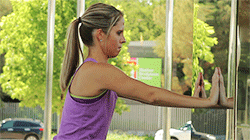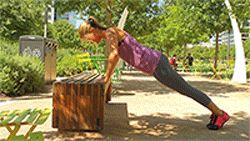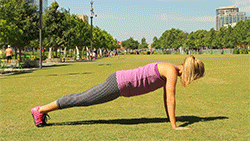Push-ups are arguably one of the most effective upper-body exercises. They can be done just about anywhere, they strengthen several muscles and there are variations that provide different benefits and levels of intensity.
Aside from the traditional push-up, one of the most common variations is the modified push-up, or the knee push-up. These are done with the knees slightly bent and touching the ground.
Fitness Events Near You
The modified version is typically used by people who struggle with regular push-ups due to injuries or strength limitations. With less weight balanced on the hands, the modified form is recognized as an easier exercise than regular push-ups.
But, how much easier is the modified version?
According to a study completed by the National Strength and Conditioning Association, regular push-ups have a ground reaction force of 64 percent, which means you're pushing 64 percent of your body weight. Modified push-ups have a GRF of 49 percent.
In addition to the difference in difficulty, each form provides benefits the other does not. While both variations are performed in a similar manner, each exercise targets different muscles in the chest, arms, core and lower body.
More: The 7 Best Exercises for a Full-Body Workout
According to Jacque Crockford, an exercise physiologist and education specialist for the American Council on Exercise, the modified version puts the body at an angle, emphasizing muscles in the back and upper chest. Traditional push-ups target the upper chest muscles, too, but can also work the triceps and lower chest muscles.
"A misconception of the push-up is that it only takes upper body strength," Crockford says. "However, to perform the 'perfect push-up,' the entire body is engaged from the hands to the feet, and it must move together as one unit, which takes tremendous strength in the shoulders, trunk, hips and legs."
If you're hoping to master the traditional push-up, but still struggle with modified push-ups, Crockford suggests the following progression strategy to improve your strength:
Wall push-ups: Begin with wall push-ups. Face a wall with your feet flat on the ground. Place your hands against the wall about shoulder-width apart, and execute the push-up motion. The further back your feet are, the more difficult the move will be.

Elevated surface push-ups: Once you master wall push-ups, try doing push-ups with an elevated surface, such as a table, chair or bench.

Modified push-ups: Progress to modified push-ups with your knees and hands on floor once the elevated surface form becomes easy.

Regular push-ups: This is the ultimate goal, so only move to this step once you can perform several modified versions without too much strain

Other exercises such as dumbbell chest press, overhead press and planks can assist in strengthening the muscles used in the push-up. Everyone has to start somewhere, so don't be embarrassed to use a progression strategy to improve your strength and become comfortable with the traditional form.
More: 30-Day Plank and Push-Up Challenge
 Sign up for a fitness class.
Sign up for a fitness class.



